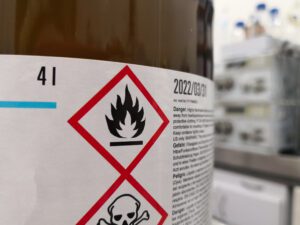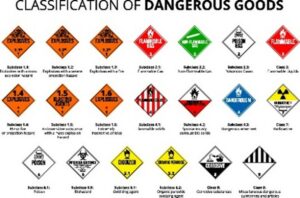Hazardous Materials and the IBC

Hazardous Materials and the International Codes
Part 1 of 2
As a sprinkler designer or as a code official, at some point in your career you will encounter hazardous materials and need to determine the applicable requirements. Understanding and applying the hazardous materials requirements in the International Building Code (IBC) and International Fire Code (IFC) can sometimes be confusing and hard to follow. Terms like “control area” and “maximum allowable quantities per control area” (MAQ) are used throughout the code. It is important to be able to define the terms that are used to apply the hazardous materials requirements.
For sprinkler designers, spaces in a building storing or using hazardous materials are often separated from other portions of the building by fire resistive construction (control areas). This will likely impact the hazard classification and the overall sprinkler design for these rooms. These areas may be identified on the architectural drawings as “control areas” and this series of blogs will provide some of the basic requirements that apply to these spaces.

Defining Important Terms
A “control area” is defined as, “spaces within building where quantities of hazardous materials not exceeding the maximum allowable quantities per control area are stored, dispensed, used or handled”.
“Maximum allowable quantity per control area” is defined as the “maximum amount of a hazardous material allowed to be stored or used within a control area inside a building or an outdoor control area.”
It is important for users of the code to have a basic understanding of the MAQ tables in the IFC, along with the related footnotes. Two of the more commonly used footnotes allow 100% increases in the MAQ when an automatic sprinkler system is present in the building meeting NFPA 13 requirements and/or when the material(s) are stored in an approved storage cabinet. These footnotes (and others) will be discussed in more detail in this blog series.

Determining the Type and Class of Hazardous Material(s)
The most important step when applying the hazardous materials requirements is to correctly determine the type of hazardous material being stored, used, dispensed, or handled. The safety data sheet (SDS) for the product should be used to determine the type and classification of the hazardous material. Correctly determining the type and class of hazardous material is important because the requirements in the codes depend on knowing this information to apply the criteria.

Applying the MAQ Tables in the IFC
IFC Table 5003.1.1(1) provide the MAQ criteria for indoor storage and use of hazardous materials classified as physical hazards. Table 5003.1.1(2) outlines the requirements for indoor storage and use of hazardous materials classified as health hazards. There are also tables for outdoor control areas for physical hazards and health hazards as well. It is important to note that for some hazardous materials, code requirements may still apply even if the material is stored outside.
The next blog in this series will discuss:
- The different requirements between storage vs. use – closed systems vs. use – open systems and why this is important to determine the requirements.
- Important footnotes in the IFC MAQ table.
- How the IFC handles storage and use in the same control area.
Members and employees of NFSA work very closely in the codes and standards development process. Our team of experts stay on the cutting edge of fire protection issues. For more information on NFSA’s mission to protect lives and property through the widespread acceptance of the fire sprinkler concept, or to join our association, please visit our membership page.
